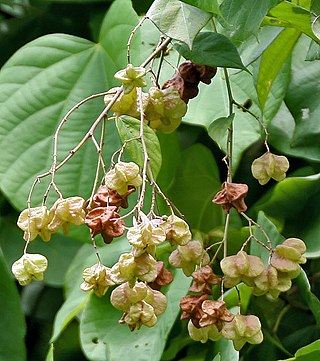
Kleinhovia is a monotypic genus of plants in the cotton, hibiscus and cacao family Malvaceae. The sole species in the genus is Kleinhovia hospita, commonly known as guest tree, an evergreen tree native to Indonesia, Malaysia and other parts of tropical Asia and the Pacific.

Alchornea ilicifolia, commonly known as the native holly, is a bush of eastern Australia. It grows in or on the edges of the drier rainforests in coastal parts of New South Wales and Queensland.

Roscoea alpina is a perennial herbaceous plant native to the Himalayas. Most members of the ginger family (Zingiberaceae), to which it belongs, are tropical, but R. alpina, like other species of Roscoea, grows in much colder mountainous regions. It is sometimes grown as an ornamental plant in gardens.
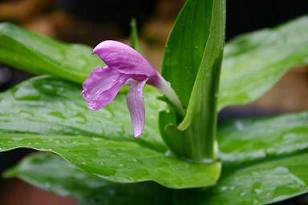
Roscoea australis is a perennial herbaceous plant found in Burma, to the south of all other members of the genus. Most members of the ginger family (Zingiberaceae), to which it belongs, are tropical, but R. australis, like other species of Roscoea, grows in much colder mountainous regions.

Lecythis zabucajo, the sapucaia or paradise nut, is a large nut-producing tree occurring in the Guianas, Suriname, Venezuela, Ecuador, Honduras and Brazil, and which distribution range is much the same as that of the greater spear-nosed bat. Although not singling out Lecythis zabucajo, Jacques Huber noted in 1909 that fruit bats played the most important role in seed dispersal in Amazonian forests. The quality of its nuts led to the species' being introduced to numerous tropical countries, notably Trinidad, where it has flourished. The nuts are a valuable food resource and yield oil suitable for cooking and domestic use.

Dillenia alata, commonly known as red beech, golden guinea flower or golden guinea tree, is a tree in the Dilleniaceae family, found in New Guinea, and the Northern Territory and Queensland in Australia. It has found some popularity as an ornamental for tropical parks and large gardens due to its colourful flowers and fruit.

Van-royena is a monotypic genus in the plant family Sapotaceae. The sole species is Van-royena castanosperma, commonly known as milky plum, yellow plum, saffron boxwood or poison plum, which is endemic to Queensland, Australia. It is an understorey tree of rainforest, first described in 1919.

Acacia burkittii is a species of wattle endemic to Western Australia, South Australia and western New South Wales, where it is found in arid zones, and is a perennial shrub in the family Fabaceae. Common names for it include Burkitt's wattle, fine leaf jam, gunderbluey, pin bush and sandhill wattle. It has also been introduced into India. Previously this species was referred to as Acacia acuminata subsp. burkittii, but is now considered to be a separate species. It grows in mallee, eucalypt and mulga woodland or shrubland, often on sandhills.

Hymenodictyon parvifolium Oliv. is a small rubiaceous African tree and is one of some 24 species in the genus, with a tropical African and Asian distribution. This species grows as a small tree to some 5 metres tall, or sometimes a liane or scrambler to 10.5 m, and is found in low-altitude woodland.
Pachystoma nutans, is a species of plant in the orchid family. It is endemic to Myanmar. It was first described by Sing Chi Chen and Yi Bo Luo in 2002. The type specimen of Pachystoma nutans was previously overlooked among unidentified Eulophia species at the Royal Botanic Garden herbarium in Edinburgh. It is only known from the type specimen, which was collected near Mong Yaw, Myanmar.

Gardenia actinocarpa is a rare and endangered plant in the coffee and gardenia family Rubiaceae, native to a very restricted area within the Wet Tropics rainforest of northeastern Queensland.
Henoonia is a monotypic genus of flowering plants belonging to the family Solanaceae. The only species is Henoonia myrtifolia. It is native to Cuba. It is a stiff bush, with a whitish bark, red-pubescent branches, alternate papery leaves of 3.0-3.8 cm long and 1.0-1.3 cm wide that grow from thickened nodes, with a very short leafstalk, shortly spade-shaped to oblong, the tip sharp or pointed, margin entire, veined, glabrous above, initially with soft rufous felty hair below but becoming glabrous with age except near the main vein. The rufous, velvety calyx of 2.5 mm long consists of 5 sepals, finally splitting under the fruit. Corolla merged, with 5 petal lobes, glabrous, with 5 anthers opposite the petal lobes. Ovary superior, unilocular, stigma simple and nearly seated. The velvety, globe- to egg-shaped berry of about 1.3 cm long is topped with a curved beak of about 0.6 cm. The endosperm is absorbed as the seed ripens, the seed skin leathery, the 2 cotyledons are leaf-like, and the embryonic root is short.
Nathaliella is a monotypic genus of flowering plants belonging to the family Scrophulariaceae. The only species is Nathaliella alaica. It is also within Tribe Scrophularieae.

Pseuduvaria glabrescens is a small tree in the custard apple family Annonaceae endemic to a very small part of coastal Queensland, Australia. It was first described as a variety of Pseuduvaria mulgraveana, and later raised to species status.
Hoffmannanthus is a monotypic genus of flowering plants in the Asteraceae. There is only one known species, Hoffmannanthus abbotianus(O.Hoffm.) H.Rob., S.C.Keeley & Skvarla Its native range is Uganda and southern Tropical Africa. It is found in the countries of Angola, Kenya, Tanzania, Uganda, Zambia and Zaïre.
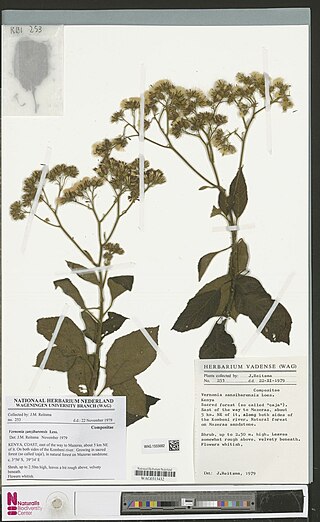
Jeffreycia is a genus of African flowering plants in the family Asteraceae. They are in the tribe Vernonieae.

Martinella is a genus of flowering plants belonging to the family Bignoniaceae. It is a genus of Neotropical lianas within the tribe Bignonieae.
Parlatoria is a monotypic genus of flowering plants belonging to the family Brassicaceae. It just contains one species, Parlatoria cakiloideaBoiss.
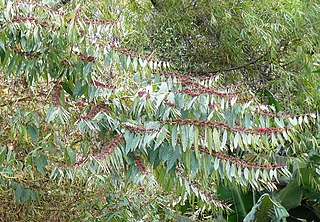
Pehria is a monotypic genus of plant in family Lythraceae. It has one known synonym, GrisleaLoefl.. The genus just contains one known species, Pehria compacta(Rusby) Sprague
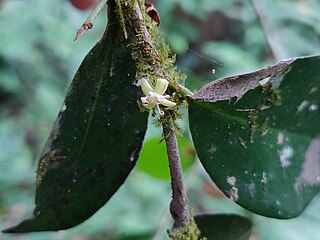
Drypetes wightii is an evergreen tree species endemic to the Western Ghats, India. The species is considered Vulnerable under the IUCN Redlist of Threatened Species.














